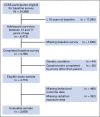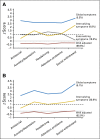Behavioral, Social, and Emotional Symptom Comorbidities and Profiles in Adolescent Survivors of Childhood Cancer: A Report From the Childhood Cancer Survivor Study
- PMID: 27432919
- PMCID: PMC5035122
- DOI: 10.1200/JCO.2016.66.4789
Behavioral, Social, and Emotional Symptom Comorbidities and Profiles in Adolescent Survivors of Childhood Cancer: A Report From the Childhood Cancer Survivor Study
Abstract
Purpose: In the general population, psychological symptoms frequently co-occur; however, profiles of symptom comorbidities have not been examined among adolescent survivors of childhood cancer.
Patients and methods: Parents of 3,893 5-year survivors of childhood cancer who were treated between 1970 and 1999 and who were assessed in adolescence (age 12 to 17 years) completed the Behavior Problems Index. Age- and sex-standardized z scores were calculated for symptom domains by using the Childhood Cancer Survivor Study sibling cohort. Latent profile analysis identified profiles of comorbid symptoms, and multivariable multinomial logistic regression modeling examined associations between cancer treatment exposures and physical late effects and identified symptom profiles. Odds ratios (ORs) and 95% CIs for latent class membership were estimated and analyses were stratified by cranial radiation therapy (CRT; CRT or no CRT).
Results: Four symptoms profiles were identified: no significant symptoms (CRT, 63%; no CRT, 70%); elevated anxiety and/or depression, social withdrawal, and attention problems (internalizing; CRT, 31%; no CRT, 16%); elevated headstrong behavior and attention problems (externalizing; CRT, no observed; no CRT, 9%); and elevated internalizing and externalizing symptoms (global symptoms; CRT, 6%; no CRT, 5%). Treatment with ≥ 30 Gy CRT conferred greater risk of internalizing (OR, 1.7; 95% CI, 1.0 to 2.8) and global symptoms (OR, 3.2; 95% CI, 1.2 to 8.4). Among the no CRT group, corticosteroid treatment was associated with externalizing symptoms (OR, 1.9; 95% CI, 1.2 to 2.8) and ≥ 4.3 g/m(2) intravenous methotrexate exposure was associated with global symptoms (OR, 1.5; 95% CI, 0.9 to 2.4). Treatment late effects, including obesity, cancer-related pain, and sensory impairments, were significantly associated with increased risk of comorbid symptoms.
Conclusion: Behavioral, emotional, and social symptoms frequently co-occur in adolescent survivors of childhood cancer and are associated with treatment exposures and physical late effects. Assessment and consideration of symptom profiles are essential for directing appropriate mental health treatment for adolescent survivors.
© 2016 by American Society of Clinical Oncology.
Conflict of interest statement
Authors’ disclosures of potential conflicts of interest are found in the article online at www.jco.org. Author contributions are found at the end of this article.
Figures


References
-
- Moore IM, Challinor J, Pasvogel A, et al. Online exclusive: Behavioral adjustment of children and adolescents with cancer—Teacher, parent, and self-report. Oncol Nurs Forum. 2003;30:E84–E91. - PubMed
-
- Gianinazzi ME, Rueegg CS, Wengenroth L, et al. Adolescent survivors of childhood cancer: Are they vulnerable for psychological distress? Psychooncology. 2013;22:2051–2058. - PubMed
-
- Schultz KA, Ness KK, Whitton J, et al. Behavioral and social outcomes in adolescent survivors of childhood cancer: A report from the childhood cancer survivor study. J Clin Oncol. 2007;25:3649–3656. - PubMed
Publication types
MeSH terms
Grants and funding
LinkOut - more resources
Full Text Sources
Other Literature Sources
Medical
Research Materials

